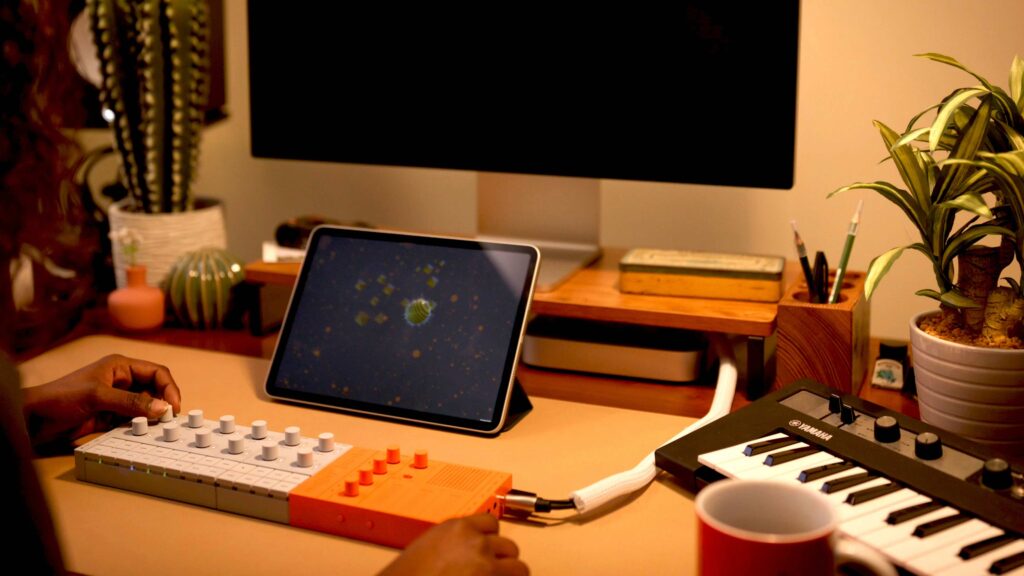“The SEQTRAK is small, incredibly lightweight, and has an onboard rechargeable battery to truly disconnect you from the confines of a home studio.”
Each January at The NAMM Show in Anaheim, Calif., you quickly get a sense of the breadth and depth of the music-gear industry. At DJ LIFE, of course, we focus on the products of interest to our DJ and producer readership, but NAMM is always a reminder that “music gear” incorporates so much more: drums, guitars, pianos, sheet music, ukuleles, saxophones, kazoos… you get the idea.
And there are no companies that have a foot in as many areas of music gear manufacturing as Yamaha, the 137-year-old, Japan-based behemoth behind Bösendorfer, Steinberg, Line 6, and a wide array of Yamaha-branded products that span drums, pianos, keyboards, guitars, pro audio, mixing desks, band instruments, music production, and more.
It’s that breadth and depth that in some ways makes it all the more surprising to see a product come to market from Yamaha as interesting as the SEQTRAK (pronounced seek-track). Described by the company as a “mobile music ideastation,” the product has been on the market for a while now, but the recently released OS 1.2 firmware update has delivered even more capabilities to this unique instrument. It pushed me over the edge; time to take a look.
First Impressions
Prior to unboxing my review unit, I hadn’t seen a SEQTRAK unit up close, so my first impressions of the device were exactly that.
What immediately came to mind was the design ethos of Swedish firm Teenage Engineering, and reading what others had to say about the SEQTRAK, apparently I’m not the only one who made that connection. As I alluded to above, it’s very… un-Yamaha to me. I was also struck by the different approach taken compared to other similar products with a similar use case, specifically the Ableton Move. The SEQTRAK is simultaneously somewhat overwhelming, with all its buttons and knobs that cover not just the top surface, but the edges of it as well. There’s a lot to take in.
So, what is the use case for the SEQTRAK that I mentioned? In short, it’s part of a larger trend of creating electronic music-making devices that untether one from one’s computer and DAW, allowing ideas to be generated, captured, and performed – anywhere, anytime, with ease.
The SEQTRAK is small, incredibly lightweight, and has an onboard rechargeable battery to truly disconnect you from the confines of a home studio.
Hands On
First things first; what does the SEQTRAK have on board?
For sound generation, the SEQTRAK offers a wavetable synth engine and sampler, along with an FM synth engine. In addition, there’s a versatile array of effects that enable myriad ways to shape those sounds. Yamaha presents those with a sectioned physical design that splits into three logical sections on the top of the instrument: drums; synth and sampler; and, sound design and effects.
The drum section sports eight knobs and 16 buttons to provide control over the sounds and a way to trigger or sequence your beats. The synth section provides four knobs and eight buttons for basic control, and the ability to utilize the buttons in the drum section for playback of notes, although for more sophisticated access to sounds, an external MIDI keyboard can be connected. Lastly, on the right section of the SEQTRAK, you’ll find controls for effects and sound-shaping, which includes three touch-based faders.
All the knobs on the SEQTRAK double as pushbuttons for previewing or making selections. And Yamaha has made excellent use of LED illumination in the form of small indicator lights, multi-color backlighting under the buttons, and backlighting under the various text legends on the device.
The SEQTRAK can be used for live performance, but I was most intrigued by its ability to play with and capture musical ideas. The array of sounds on-board covers a lot of territory, as do the effects. Is it possible to build a complete track using only the SEQTRAK? Well, yes, actually, but I can imagine a wide range of use cases, from augmenting DJ sets, to providing the foundation for a performance, to sketching out ideas that are later leveraged through MIDI export to a full DAW and not even using the SEQTRAK’s own sounds at all in the final product.

To be candid, it’s a little tough to try and put the SEQTRAK into a single creative bucket. With an investment in the learning curve, in the end, it turns out to be a chameleon that fills any number of difference niches.
The full potential of the SEQTRAK is, to be fair, dependent on the use of one or more of its companion apps. Available for iOS/iPadOS, Android, Windows, and Mac, the apps more than make up for the lack of any sort of display on the device itself, while providing a wide array of functionality – from interactive tutorials to networking to project and sound management to an easier way to see and access device settings in real time to (of course) firmware updating.
Kudos to Yamaha are justified here, too; the app is well-designed, intuitive, easy-to-use, and reflects the design ethos of the SEQTRAK itself throughout. The software leverages Bluetooth, WiFi, and/or USB connections to access and enable functionality on the SEQTRAK itself. It’s a clever way to simplify the device itself, without sacrificing capability.
It’s worth calling out that the SEQTRAK includes both an onboard speaker and an onboard microphone. The speaker, of course, can be used for playback, while the mic can be used to sample real-world sounds. As you’d expect, perhaps, their actual utility is limited; I’d strongly suggest a pair of headphones or IEMs plugged into the unit to really hear what the SEQTRAK is capable of, and an audio input is also provided. (There’s a MIDI jack, too; the SEQTRAK comes with the necessary custom cable for that to leverage off-board devices.)
Conclusions
The SEQTRAK was an instrument that surprised me at every turn. I don’t know the back story of the product; what prompted Yamaha to create it, or the thought processes that went into it. But the end-result is a product that reflects some serious out-of-the-box thinking; something that innovates, but keeps its foundations anchored in reality. It’s a tricky balance, but in the SEQTRAK, it feels like Yamaha’s onto something. I’ll be anxious to see if, when, or how the company might choose to top itself with a future iteration of the SEQTRAK. But with a current street price right around the $300 mark, it feels like it hits a sweet spot with price and performance – a viable contender in a new market segment that’s poised to fundamentally change the way creatives approach beat-based music projects for years to come.


![Mobile Ideastation: Yamaha’s SEQTRAK [Review]](https://djlifemag.com/wp-content/uploads/2025/05/SEQ_PRODUCT_Lifestyle_002-768x432.jpeg)